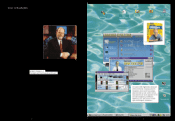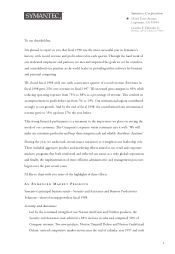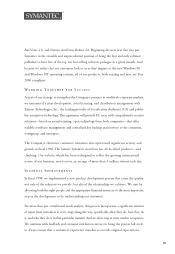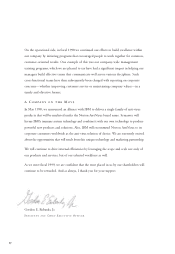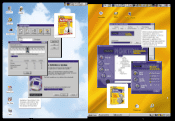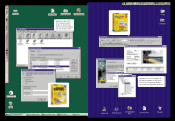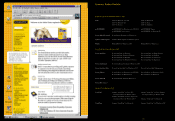Symantec 1998 Annual Report Download - page 14
Download and view the complete annual report
Please find page 14 of the 1998 Symantec annual report below. You can navigate through the pages in the report by either clicking on the pages listed below, or by using the keyword search tool below to find specific information within the annual report.
SYMANTEC CORPORATION
SYMANTEC CORPORATION 1514
Item 7: Management’s Discussion and
Analysis of Financial Condition and
Results of Operations - Technical Support.)
PRODUCT DEVELOPMENT,
PARTNERSHIPS AND
ACQUISITIONS
Symantec uses a multiple product sourcing
strategy that includes internal develop-
ment, licensing from third parties and
acquisitions of technologies, product lines
or companies, as necessary. Symantec
typically develops new products and
enhancements of existing products in its
business units. Each group’s responsibilities
include design, development, documen-
tation and quality assurance. Independent
contractors are used for certain aspects of
the product development process, and
elements of certain Company products
are licensed from third-party developers.
During fiscal 1998, Symantec entered
into strategic relationships with various
companies including Entrust Technologies,
Inc. (“Entrust”), Hewlett-Packard and
Microsoft Corporation (“Microsoft”).
Entrust has agreed to a joint development,
cross-licensing and distribution arrange-
ment with Symantec for the development
of secure desktop suites which will provide
comprehensive, easily managed desktop
solutions. In addition, the secure desktop
suites are expected to provide scalable
certificate management and centralized
key backup and recovery to the consumer,
workgroup and enterprise. (See further
discussion in Item 7: Management’s
Discussion and Analysis of Financial
Condition and Results of Operations -
Reliance on Joint Business Arrangements.)
Hewlett-Packard has agreed to incor-
porate Symantec’s pcANYWHERE32
remote-control software package on all
Hewlett-Packard Brio personal computers
targeted for small and medium sized
companies without an information tech-
nology staff. Hewlett-Packard will also
provide pcANYWHERE32 free of charge
to its resellers.
Microsoft and Symantec have entered
into a strategic relationship to deliver
integrated technology capabilities to the
Microsoft Outlook 98 messaging and
collaboration client. The first project
from this relationship will be the inclusion
of WinFax Starter Edition, which includes
components of Symantec’s WinFax PRO
software, in Microsoft Outlook 98. The
second project from this relationship is
expected to be the integration between
Symantec’s new ACT! contact manager
and Microsoft’s Outlook 98.
On May 19, 1998, IBM and Symantec
Corporation entered into an agreement
whereby Symantec will license IBM’s
immune system technology and patents.
Symantec will combine this technology
with its own technology to produce a
range of products, including new solutions
to support IBM platforms. As part of the
agreement, IBM has also assigned its
existing anti-virus customer and OEM
contracts to Symantec and will recom-
mend Norton AntiVirus to its corporate
customers worldwide as the anti-virus
solution of choice. In addition, IBM and
Symantec intend to sell and market the
Norton AntiVirus product line worldwide.
(See further discussion in Note 17 of Notes
to Consolidated Financial Statements in
Part IV, Item 14 of this Form 10-K.)
The Company is devoting substantial
efforts to the development of software
products that are designed to operate on
various operating systems. Symantec’s
total research and development expenses
were approximately $91 million, $89 mil-
lion and $95 million in fiscal 1998, 1997
and 1996, respectively. Research and
development expenditures are charged to
operations as incurred. The current U.S.
accounting standard, Statement of
Financial Accounting Standards (SFAS)
No. 86, “Accounting for the Costs of
Computer Software to be Sold, Leased, or
Otherwise Marketed,” did not materially
affect the Company in fiscal 1998 and 1996.
In fiscal 1997, Symantec capitalized
approximately $8 million of software deve-
lopment costs, primarily related to network
administration technology, which was sold
to Hewlett-Packard in March 1997, result-
ing in the write-off of approximately $7
million of unamortized costs during the
fourth quarter of fiscal 1997. (See further
discussion in Item 7: Management’s
Discussion and Analysis of Financial
Condition and Results of Operations -
Operating System; Uncertainty of
Research and Development Efforts;
Length of Product Development Cycle.)
Symantec uses strategic acquisitions,
as necessary, to provide certain technology,
people and products for its overall product
strategy. The Company has completed a
number of acquisitions and dispositions
of technologies, companies and products
and may acquire and dispose of other
technologies, companies and products in
the future. (See further discussion in
Item 7: Management’s Discussion and
Analysis of Financial Condition and
Results of Operations - Management of
Expanding Operations.)
COMPETITION
The microcomputer software market is
intensely competitive and is subject to
rapid changes in both technology and
the strategic direction of major micro-
computer hardware manufacturers and
operating system providers. The Company’s
competitiveness depends on its ability to
enhance its existing products and to offer
successful new products on a timely basis.
The Company has limited resources and
must restrict its product development
efforts to a relatively small number of
projects. (See further discussion in Item 7:
Management’s Discussion and Analysis
of Financial Condition and Results of
Condition and Results of Operations -
Site Licenses; Channel Fill.)
Agreements with distributors are
generally nonexclusive and may be termi-
nated by either party without cause. Such
distributors are not within the control of
Symantec, are not obligated to purchase
products from the Company and also
represent other vendors’ product lines.
(See further discussion in Item 7:
Management’s Discussion and Analysis
of Financial Condition and Results of
Operations - Retail Distribution Channel.)
Information with respect to customers
that represent more than 10% of the
Company’s revenues may be found in
Note 16 of the Notes to Consolidated
Financial Statements in Part IV, Item 14
of this Form 10-K.
Symantec’s return policy allows its
distributors, subject to certain limitations,
to return purchased products in exchange
for new products or for credit towards
future purchases. End users may return
products through dealers and distributors
within a reasonable period from the date
of purchase for a full refund, and retailers
may return older versions of products.
Various distributors and resellers may
have different return policies that may
negatively impact the level of products
which are returned to Symantec. Product
returns occur when the Company intro-
duces upgrades and new versions of
products or when distributors order too
much product. In addition, competitive
factors often require the Company to
offer rights of return for products that
distributors or retail stores are unable to
sell. (See further discussion in Item 7:
Management’s Discussion and Analysis
of Financial Condition and Results of
Operations - Product Returns.)
Symantec’s marketing activities
include advertising in trade, technical and
business publications, on-line advertising,
public relations, cooperative marketing
with distributors, resellers and dealers,
direct mailings to existing and prospective
end users and participation in trade and
computer shows. Additionally, the
Company typically offers two types of
rebate programs: volume incentive rebates
and rebates to end users. Volume incentive
rebates are made available to Symantec’s
distributors and resellers whereby the
distributor or reseller earns a rebate based
upon their purchases and sell-through of
products to end users. Volume incentive
rebates are accrued when revenue is
recorded. From time to time, Symantec
also makes rebates available to end users
of various products who acquired the
products through major retailers. End
user rebates are accrued when revenue is
recorded. (See further discussion in Item 7:
Management’s Discussion and Analysis
of Financial Condition and Results of
Operations - Sales and Marketing.)
International Revenues
International revenues outside of North
America represented approximately 32%,
29% and 32% of Symantec’s net revenues
in fiscal 1998, 1997 and 1996, respectively.
The majority of Symantec’s net
revenues from certain European regions
are derived from sales by affiliates of
Symantec’s major United States distribu-
tors. In other countries, Symantec sells its
products through authorized distributors.
In some countries, these distributors are
restricted to specified territories. Symantec
typically adapts products for local markets,
including translating the documentation
and software where necessary, and prepares
marketing programs for each local market.
Symantec has established marketing
offices in Argentina, Australia, Brazil,
Canada, Denmark, France, Germany,
Holland, Hong Kong, Italy, Japan, Korea,
Malaysia, Mexico, New Zealand, Russia,
Singapore, South Africa, Sweden,
Switzerland, Taiwan and the United
Kingdom. These local offices facilitate
Symantec’s marketing and distribution
in international markets. The Company’s
international operations are subject to
certain risks common to international
operations, such as government regula-
tions, import restrictions, currency
fluctuations, repatriation restrictions and,
in certain jurisdictions, reduced protection
for the Company’s copyrights and trade-
marks. (See further discussion in Item 7:
Management’s Discussion and Analysis
of Financial Condition and Results of
Operations - Foreign Operations.)
Information with respect to international
operations and export sales may be found
in Note 16 of Notes to Consolidated
Financial Statements in Part IV, Item 14
of this Form 10-K.
Customer Support
Symantec’s product support program
provides a wide variety of free and fee-
based technical support services to its
customers. Symantec provides its customers
with free support via electronic and auto-
mated services as well as 90-days free
telephone support for selected products.
In August 1996, Symantec introduced
LiveUpdate, which provides instant access
to on-line application bug-fix patches for
most of Symantec’s currently marketed
and developed products. In addition,
Symantec offers both domestic individual
users and domestic corporate customers a
variety of fee-based options designed to
meet their technical support requirements.
These fee-based support programs are
revised from time to time as customer
requirements change and as market trends
dictate. Symantec also offers Chat Now!™,
a fee-based technical support service via
the Internet. Fee-based technical support
services did not generate material revenues
in any fiscal years presented and are not
expected to generate material revenues in
the near future. (See further discussion in


